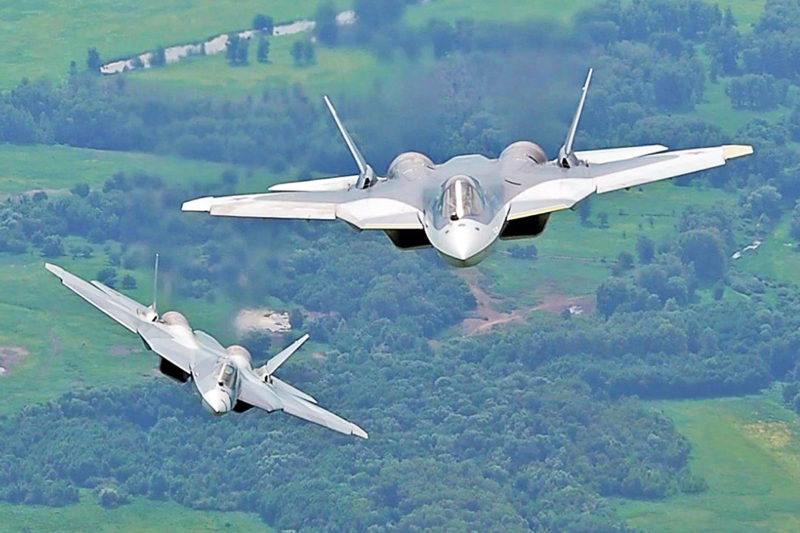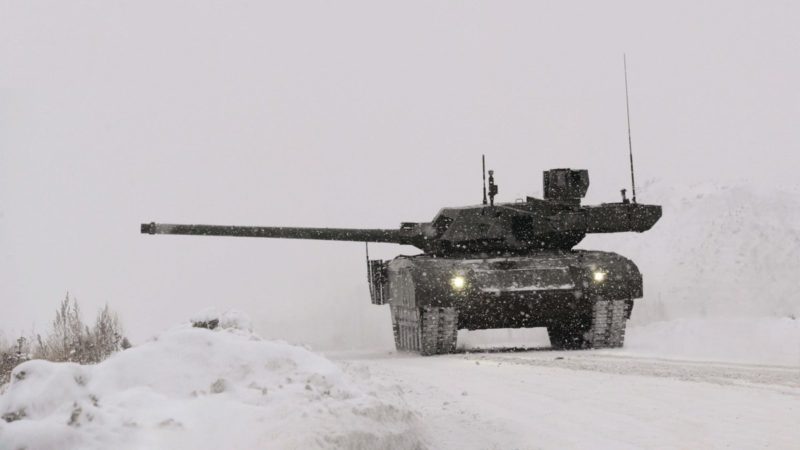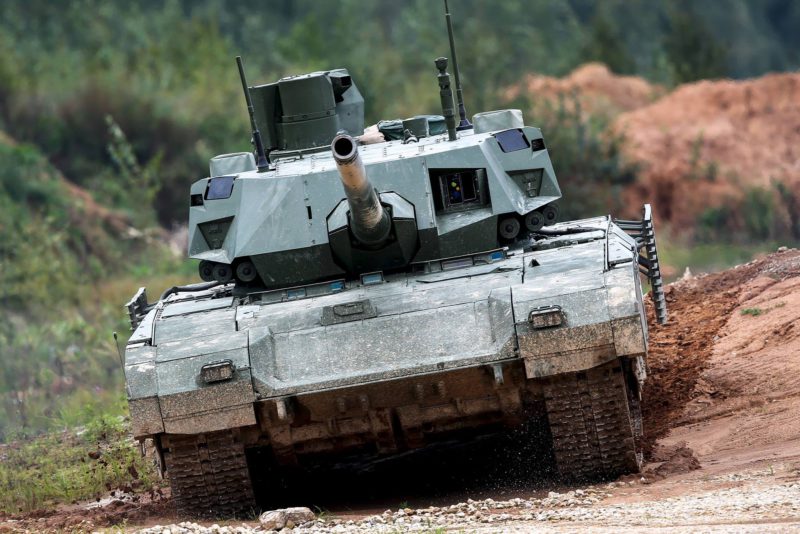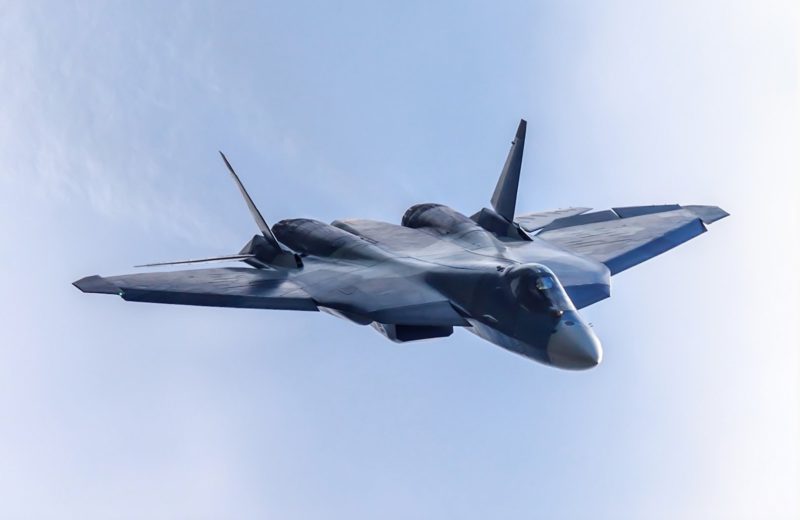T-14 Armata and Sukhoi Su-57 update: For the past two months, the internet has been awash with rumours regarding both platforms and discussions on whether or not those two programs are being canned.

In early July 2018, it was announced that the Su-57 would not be rushed into serial production any time soon… Instead, the planes would slowly trickle down the assembly lines: 12 units were ordered in June 2018, to be added to the 11 prototypes already produced. The production goal seems to currently be 2 units per year… Borisov, Russia’s deputy defence minister, went as far as saying Moscow retains the ability to order full scale production of the Su-57 whenever needed. The claim is dubious, but only the future will tell.
Then, in early August 2018, Moscow announced that the T-14 Armata will not be mass produced either. Instead, a smaller order of 100 initial units would be procured. Borisov used the same language he used when talking about the Su-57: The T-14 is excellent, we do not need it straight away, we can launch production any time we want, we can use it as a trump card in our hour of needs…

Is Moscow broke ? Can’t it afford its new wonder weapons ? Or are the Su-57 and the T-14 not as good as the hype led us to believe ?
Well, the truth is a little bit more nuanced and the answers resides as much in politics as they can be found in economics.
During Putin’s two first terms as president of the Russian federation, between 2000 and 2008, the Russian economy boomed. This was helped by high oil and gas prices and by a relatively peaceful era of cooperation between Moscow and the West. The economy grew, the foreign debt fell, the salaries, pensions and quality of life of Russian citizens increased and so was their life expectancy. Then 2014 happened, with the Ukrainian and Crimean crisis. What followed were several rounds of international sanctions slapped against Russia. Worse, still, the international sanctions hit just as oil and gas prices crashed, hitting the Russian budget with a double whammy. The next 3 years saw Russia endure a recession (2014-2017) which partially wiped away the progress made in the past 14 years: Russian citizens, suddenly, were confronted with a drop in quality of life.
This did not stop Moscow from getting involved in Syria and keep on pouring money in its armed forces: While the current procurement and modernisation plan for the Russian armed forces (2018-2027) is less ambitious than its predecessor (2011-2020), it is still a far reaching program, compared to what we see, say, in the West.
The Russian economy finally recovered in 2018, with forecasts predicting a growth of between 1% and 2%. And this is apparently the time Moscow picked to slash its defence budget and put the brakes on two of its star programs: The Su-57 and the T-14. Why ? Surely, it does not make sense to have poured large quantities of resources in building those two program, just to abandon them as they reach maturity…
Money is a problem, but not as we see it: Both the Su-57 and T-14 are high end products that require modern assembly lines to be mass produced. UralVagonZavod somehow upgraded its production lines to deal with more modern platforms such as the T-72B3 obr. 2016, the T-80BVM and the T-90M. But to mass produce the T-14 would require its assembly lines to be completely overhauled, or for new high tech ones to be manufactured. And this would require large quantities of money. Not only that, but the current assembly lines are working around the clock to produce T-90S for export markets as well as to overhaul and modernise Russia’s T-72B3, T-80 and T-90 to newer variant/standards.
As for OmskTransMash, the other major Russian Tank plant, its assembly lines have seen even less investment than at Ural’s and the workforce there is more used to produce parts and kits than full tanks built from the ground up. It will take even more time and money to bring this factory and its work force up to the standards needed to be able to mass produce the T-14.
The same problem is found at Komsomolsk-on-Amur Aircraft Plant, the subcontractor Sukhoi had selected to produce/mass produce the Su-57. Sukhoi’s other sub contractor, Irkut Corporation suffers from the same lack of investment. Both those factories can mass produce advanced Su-30 and Su-35 variants, but mass producing the Su-57 would require for them to invest massive amounts of money into modernising their plants and training their workforce.
So, is money the only factor behind the decision to not mass produce the T-14 and Su-57 ?
Yes and No. The main root is political !
This is probably Putin last mandate as president. The mandate during which he is going to try and polish his legacy, both abroad and at home. He is going to try and please Russia’s civilian society as well as its military. Money is limited and he has to make hard choices. The Russian armed forces are pursuing an increasingly large amount of programs, on land, at sea and in the air and something’s got to give. As for the civilians, they have suffered in the past 3-4 years and they expect their government to do more to improve their quality of life in particular and the Russian economy in general.
Putin promised to rebuild and modernise the army and that goal has been largely achieved with the 2011-2020 program, revised into the 2018-2027 program. He promised to make Russia great again (to borrow another slogan) and while Russia is no superpower, it still punches way above its height in all departments, and is central, diplomatically speaking, to most big crisis currently unfolding in the world. Not too shabby.
However, Putin might want to sort out his legacy at home: infrastructure, education, economy, all necessitate his attention. And for that, he needs funds. Hence the cut in the defence budget. If he can put in place the reforms needed to enable the Russian economy to grow faster and better and wean itself from oil sales, he will depart on a high with a positive legacy on the home front.
The challenge is steep and Putin only has 6 years ahead of him to overcome it. Steps have already been taken: While oil and gas revenues account for 40% of Moscow’s federal budget, this figure used to be much higher not that long ago. The Russian economy fights to diversify and wean itself from its dependency on oil and gas exports: The Russian federal budget has seen cuts to balance the books on par with an estimated oil price of $40 a barrel. Russian budget breakeven point is now calculated on a barrel price of $53. The breakeven point used to be around $70 to $115 a decade ago. So on that side of things, Moscow is making progress.
After the recession years of 2014-2017, the Russian economy is now growing at a rate of between 1% and 2%. And thanks to its reforms and buoyant oil prices, Russia is now on course to create its first budget surplus since 2011. (Oil prices in recent years: 2014 $88.47 ; 2015 $42.22 ; 2016 $37.02 ; 2017 $42.63 ; 2018 higher $60’s, lower $70’s).
Things are not all rosy, however…
Moscow has a policy of keeping the inflation down, as inflation is the first thing to impact people’s quality of life. However, this tight monetary policy is hampering the recovery/growth of the Russian economy. Another thing working against Moscow is the lack of foreign investments due to fear of sanctions. And talking about sanctions, it seems the US and the EU are hell bent on producing increasingly aggressive economic sanctions against Russia. This will surely play against a swift recovery of the Russian economy in the long term. Moscow might find ways to churn out a modest growth on an annual basis, but its economy will only really hit its strides and work on par with its true potential only when it will be reintegrated into the global economic and financial markets.
Another one of Putin’s priorities is to rebuilt Russia’s Federal cash reserves.
Russia’s Reserve Funds, a Sovereign Fund, was set up in 2008 to serve as a currency reserve in case of needs. It was tapped into from 2014 onward as international sanctions and a crash in oil price led the country into a recession between 2014 and 2017. The fund served its purpose as it was used to top up the federal budget during that time, enabling the government to be more progressive in their austerity measures than they would have had to be, if that fund had not existed. That fund is now essentially exhausted.
The plan, now, is to replenish another Sovereign Fund: The Russian Sovereign Wealth Fund. That fund will act as another currency reserve, should the oil price crash again. However, this fund is also earmarked to be used to purchase foreign bonds as well as finance infrastructure projects within the Russian Federation.
The Russian Sovereign Wealth Fund main source of income will be budget surplus (Moscow took the decision not to spend any budget surplus) as well as any surplus generated by oil and gas sales when the oil prices are high enough to generate said surplus.
There again, if Putin leaves the presidency with a buoyant sovereign fund, he can claim to leave on a high note.
So, where does that leave the T-14 and Su-57 ?
The Russians are now talking about fielding 100 T-14, which would probably be deployed in elite battalions within the Western Military District. We could see the same thing happening with the Su-57 being fielded in a handful of elite squadrons.
It is also common knowledge that both the T-14 and the Su-57 are still being thoroughly tested and developed. A couple of the original Su-57 prototypes could therefore be used as technology test beds just as the Su-47 Berkut and Su-37 once were.
In the meantime, the technology developed for those machine will surely trickle down the assembly lines and find themselves integrated into existing platforms such as the Su-30, Su-35, T-72B3, T-80BVM and T-90M.
Which technologies are we talking about ?
T-14

A lot can be borrowed from the T-14 to be incorporated into existing tank variants: The Malachit ERA and Afghanit APS including its AESA radar could easily be incorporated into existing designs.
So is the T14’s 2A82-1M main gun and autoloader which are capable of handling the Vacuum-1 APFSDS round (it has a longer penetrator rod than classic Russian ammunitions). This gun assembly has already been fitted to the new T-90M.
Su-57

Here again, the Su-57 is a treasure trove of high-end electronic systems that could be integrated into existing platforms:
The Sh121 multifunctional integrated radio electronic system (MIRES) is one of them. The Sh121 includes the X-band active electronically scanned array system (AESA) N036 Byelka radar, a L-402 Himalayas radar fitted in the tail of the plane, two X-band NO36B Side Facing Cheek-Mounted Radars on either side of the cockpit and two L-band N036L-1-01 radars mounted on the leading edges of the plane’s wings.
The 101KS ‘Atoll’ IRST is another bit of kit that could be integrated into existing designs.
The Directional Infrared Countermeasures System turrets (DIRCM) coupled with the plane’s Missile Launch Detector Apertures designed to detect and blind incoming missiles are also solutions that could be used for any existing or upcoming designs.
And finally, we have the Izdeliye-30 turbofan engines with supercruise capabilities and thrust vectoring.
To sum it up.
Russia has spend a fair amount on cash into its military since 2011. It seems now is the time to spend some of that federal budget money into diversifying the Russian economy and work toward leaving a positive impression on the Russian population so as to help Putin establish a positive legacy ahead of his exit from the presidency.
It is also a given that the Russian economy needed to be overhauled and adapted to new realities: Enduring Western economic sanctions and volatile oil prices. It would not have been sustainable for Russia to keep on splashing the cash on its military without reforming its economy.
It can be said that international sanctions and volatile oil prices have introduced a dose of realism within the Russian leadership. Its current stock of upgraded tanks (T-72B3 Obr. 2016, T-80BVM and T-90M ) and fighter planes (Su-30, Su-35, upcoming MiG-35), coupled with the thousands of legacy/older designs still being operated, are more than enough to deal with any military threat that could potentially arise in the region, except for a full-on war with NATO. There is therefore no justification for the billions that would have been necessary to enable the Russian industry to mass produce hundreds of Su-57 and T-14 and for the Russian armed forces to procure those platforms in such high numbers. Doing so would have required serious sacrifices from the Russian population, and it seems said population would not have tolerated such a move. The last thing Putin wants during his last mandate is trouble in his own house, in his own streets.
This does not mean the Russians are giving up on their military: The defence budget is still sizeable and the army is still expanding, modernising and procuring hundreds of new / modernised platforms. But choices had to be made.
As for the T-14 and Su-57, they will probably not be cancelled. But they will certainly never play the big role Russian planners dreamed for them a decade ago, settling for a niche role within a few elite outfits instead.










